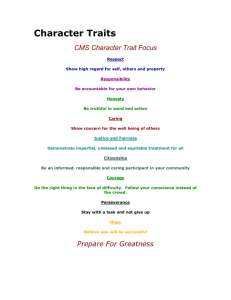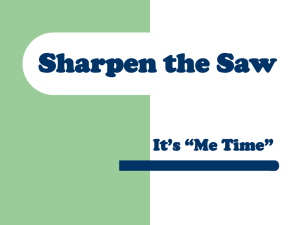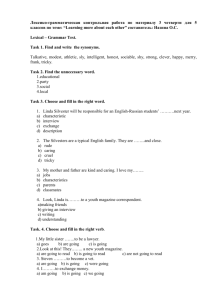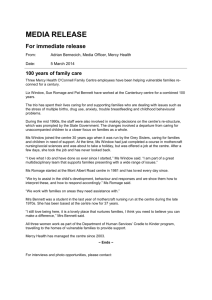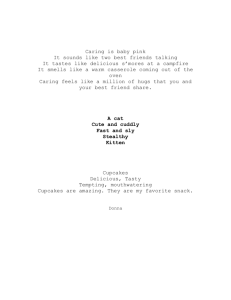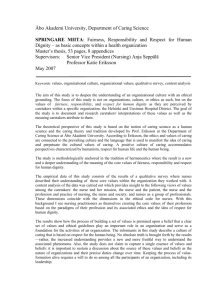European model of cultural caring for caring Sciences
advertisement
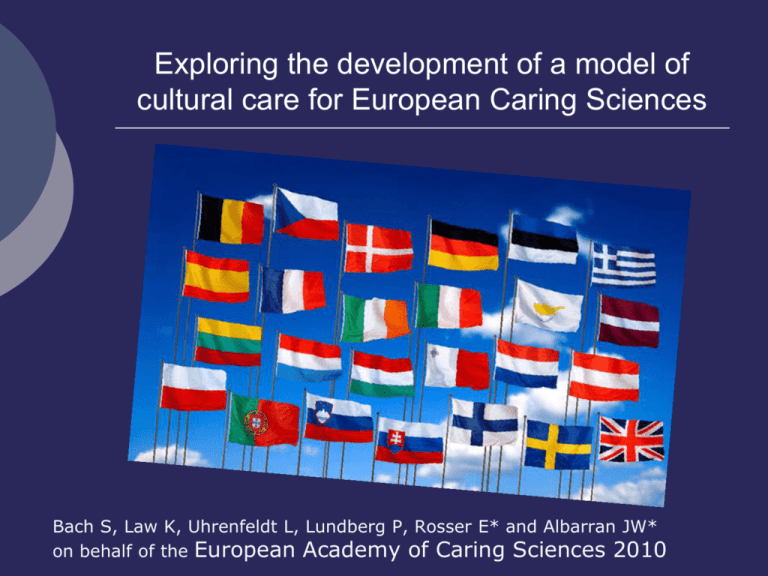
Exploring the development of a model of cultural care for European Caring Sciences Bach S, Law K, Uhrenfeldt L, Lundberg P, Rosser E* and Albarran JW* on behalf of the European Academy of Caring Sciences 2010 Aims Explore the relationship between caring sciences and cultural care. Critically assess how cultural caring has been embraced and communicated within caring science literature Propose a template for the development of a caring sciences cultural care model Introduction- the context Ethnic minority groups typically suffer from higher rates of morbidity and mortality when compared with indigenous populations Healthcare systems fail to address the needs of such groups Migration and immigration- immigrants/refugees may be suffering from health and emotional problems posing challenges for healthcare providers (Jenko and Moffitt 2006; Domenig 2007) Caring sciences I Caring science can be firmly situated in the Western, liberal, individualist tradition It has strong epistemological and ontological roots, chiefly in the Nordic countries, which are humanistic and undeniably spiritual, focusing on caring as caritas (love & charity), suffering, well being, patience, sacrifice and healing, (Eriksson 2002, Ekebergh 2009) The aim of care is to alleviate patient suffering and promote the health and wellbeing of individuals (health as having, health as being, and health as becoming) (Eriksson 1992) Respect, sensitivity and empathy are inherent in this approach to care, values deeply embedded in a Christian European tradition (Gustafson 2005) Caring sciences II Philosophical values and beliefs of caring sciences People are indivisible and comprise of body, soul, & spirit (spiritual dimension affects a person’s health and is expressed by religious or existential experiences (Fagerström & Engberg 1998) Humans are fundamentally religious Humans are fundamentally holy (human dignity and accepting obligations towards others eg love, existing with others) Humanistic orientation which embraces culture and open theory The basic category of caring is suffering and the basic thrust behind caring is the caritas motive which means love and charity Caring involves alleviating suffering Caring relationships shaping the context for caring and the basis of love, responsibility and sacrifice (Eriksson 1992) Interdisciplinary science Caring Sciences III Requires the complex integration of humanly sensitive care that includes: A particular view of the person A unique perspective of evidence that can guide caring A particular view of care that is lifeworld led and consequently, by its very nature holistic (Galvin 2010; 169) Lifeworld dimensions are intertwined and encompass: Temporality Experiencing of time (past, present and future) Spatiality Maintaining connections with locations/environments, objects and events that give meaning to experience Relational (intersubjectivity) Embodiment (corporeality) Experiences in relation to others and in the world with others We experience life/world through our bodies Culture and cultural care I Culture is defined differently by individual disciplines and employed to suit various purposes, however it is not a static and fixed concept The learned and shared beliefs, values and lifeways of a designated or particular group which are generally transmitted inter- generationally and influence one’s thinking and action modes (Leininger 1995) Culture can be source of pride, political power, a means of support and for promoting health (Culley 2008) In healthcare, culture determines how patients and care-providers react and respond to health, illness beliefs, health practices, the delivery of care and associated interventions Culture and cultural care II General principles informing transcultural care acknowledge that: The provision of cultural care is an ethical obligation Appreciation of cultural background or lifeworld enables health professionals to provide care that is culturally sensitive, relevant and adapted to the needs of an individual and their family (Domenig 2001) Promoting awareness, sensitivity, competence and practice is to caring experiences Aims should on guaranteeing humanistic caring within a multicultural society Transcultural care considers, person, cultural identity and environment Concerns relating to explanations of culture Definitions of culture overplay ethnicity consequently narrowing its utility The literature fails to address political, historical and social influences Culture and difference are often problematised Culture and cultural care III Increasingly notions of culture and trans-cultural, cross cultural, cultural or intercultural care are being seen as central to caring science (Gebru and Willman 2003, Wikberg and Eriksson 2008, Pergert et al 2003) Wikberg and Eriksson (2008) have proposed that an intracultural model of care aims to assist clinicians to relieve suffering, prevent discontinuity of care and treatment and improve well-being and health- all of these objectives being central to a caring science approach to health care The extent to which caring science has developed a model to embrace transcultural care remains unknown, therefore an analysis of the literature may provide insights into this area of care provision Methods We systematically searched bibliographic databases and Scandinavian journals from 1998 onwards All papers with ‘Caring Sciences’ in the title were selected for analysis Papers in English and Scandinavian languages were included All accessed papers were thematically analysed for evidence of (trans/inter/cross) cultural caring discussions Results 22 papers were accessed from eight different journals Type of output Editorials n= Themes raised 12 Progress of Caring Sciences as a discipline and growing frontiers, role of SJCS; methodological issues and challenges for Caring Science(s) Conceptual/ philosophical analyses 8 Concepts of caring science and lifeworld; application of qualitative methods in caring science(s) Studies 2 Essence of suffering in different clinical contexts (eg family suffering in relation to war experiences; psychiatric patient outlook) Summary Cultural care is not fully explicated within caring sciences It may be presumed that the cultural aspects of caring are integral to the philosophical values and beliefs of caring sciences forming part of a humanistic, holistic and spiritual model Unless this is made evident, there is no beacon to guide practitioners on how to address individuals needs which may embrace cultural characteristics that shape the lifeworld of humans. Developing a way forward We critically reviewed a range of cultural models for the following criteria: Have congruence with Caring Sciences values and beliefs Acknowledge a particular view of people (spirit, religion) A unique outlook on evidence base to guide caring A distinctive focus on care that is lifeworld led and consequently, by its very nature holistic Caring and trusting relationships and partnerships are integral in the caring experience Interdisciplinary approach to caring Conceptually relevant and empirically validated Have broad international appeal Intuitive and have practical simplicity Further thinking in conjunction with analysis of Caring Sciences and Transcultural Care (EACS, Vaxjo 2008) Internal Values ,e.g. equality, freedom Ethics Sense of space Value of life Touch Health beliefs and attitudes to health promotion Attitudes to authority External Geography Influencing factors Expression, e.g. hair, Dress, Body decorations Home Community Heritage, Sense of place History, e.g. imperialism Colonialism Oppression Dominance Wealth/Economy Life course Parenting/childhood Reasons for selecting Giger and Davidhizar’s transcultural model • This model shares a synergy with core dimensions of the lifeworld to assessment of need and caring practices and in terms of religion, culture and spirituality; nature and scope of relationships and caring motivations • The model has been applied to variety of groups, with much work focused on healthcare experiences of migrants to the US; with the influx immigrants across Europe such a model may pave a way for caring and supporting individuals and families from a caring sciences ideology • Giger and Davidhizar has a very inclusive approach to addressing transcultural issues and it integrates family perspectives in a holistic manner (Jenko and Moffit 2006) • Like with all other models, the idea of partnership working is key Giger and Davidhizar transcultural assessment model Religion, culture and spirituality are key expressions which inform the cultural being together with six transculural domains and each is assessed individually Communication Time Space Biological variations (growth, development, disease, nutrition) Environmental control Social organisations (family, tribe, religious groups, affiliations) These concepts are borrowed from biomedical and social sciences disciplines and when applied can enable practitioners to understand the patients’ cultural perspective and the impact each has on their health Promoting health and wellbeing Individual’s lifeworld Knowledge & skills applied to address cultural nuances (eg religion, faith, diet) Internal values • Space • Time External expressions • Intersubjectivity • Corporality •Emotional attunement Influencing factors • Geography (home, community, heritage) • • • • • Social organisation Economic status History (oppression, parenting) Social biology Spirituality Caring milieu Fig 1.Determinants of cultural lifeworld led care Humanising caring Holistic focus Application This proposed framework can be used to consider the needs of patients, clients and care givers from ‘cultures’ constructed by gender, sexuality, economic differences, class, (dis) ability and age. Viewing these constructs through a cultural lens, illuminates the complexities of culture, and assists the realisation that culture does not merely relate to ‘ethnicity ’ or ‘foreignness’. It offers a platform to guide, inspire and facilitate health providers to focus their endeavours on promoting humanistic caring which embraces partnership, respect, dignity, understanding of a individual’s lifeworld ways in their various contexts Culturally competent care, if accepted as an achievable and appropriate aim, is then taken as an aim for all and not just those deemed as ‘the other’. Conclusion Journey of exploration to find a link between cultural care and caring science Little available literature specifically in the context of caring science but the wider cultural debates recognise: If differences are not acknowledged the risks reproducing racial stereotypes are high If it is accepted that people are individual and unique, cultural differences become relative, then aspects of marginalisation such as homophobia, racism can potentially be ignored From the available cultural models G&D, offers synergy with core dimensions of the individual’s lifeworld, inclusivity involving family and significant others and a practicality, allowing caring science disciplines to focus on the humanity of individuals in their clinical assessment The proposed hybrid framework highlights how individuals interpret, experience and respond to health and ill-health; it focuses on shared human characteristics and encourages care that is humanising, dignified and respectful of individuals Additionally the lifeworld perspective will provide clear directions for care, and help with descriptions and experiences relevant to caring (Galvin 2009) We continue our journey and welcome your thoughts References Culley L. (2008) Cultural diversity and nursing practice. Journal of Research in Nursing, 13(2), 86-88 Domenig D.(2007) Transcultural competence in the Swiss Healthcare system. In Domenig D, Fountain J, Schatz E, Broring G. Overcoming Barriers – migration, marginalisation and access to health and social services. Foundation RegenboogAMOO, Amsterdam. Domenig D. (2001) Migration, Drogen, transkulturelle Kompetenz. Bern: Verlag Hans Huber. Giger J.N. & Davidhizar R.E. (2004) Transcultural Nursing (4th edition) Mosby, Missouri. Ekebergh M. (2009) Developing a didactic method that emphasizes lifeworld as a basis for learning. Reflective Practice, 10(1), 51-63. Eriksson K. (2002) Caring Science is Key. Nursing Science Quarterly, 15(1), 61-65 Eriksson K. (1992) Different forms of caring communion. Nursing Science Quarterly, 5(2), 93 Fagerstrom L.& Engberg I.B.(1998) Measuring the unmeasurable: a caring science perspective on patient classification. Journal of Nursing Management, 6(3), 165-172 Galvin K. (2010) Revisiting Caring Science: some integrative ideas for the “head, hand and heart” of critical care nursing practice. Nursing in Critical Care, 15(4), 168-175. Gebru K. & Willman A. (2003) A Research-Based Didactic Model for Education to Promote Culturally Competent Nursing Care in Sweden. Journal of Transcultural Nursing 14(1), 55-61 Gustafson D. (2005) Transcultural Nursing Theory From a Critical Cultural Perspective. Advances in Nursing Science, 28(1) 2-16. Jenko M.& Moffitt S.R. (2006) Transcultural Nursing Principles: An Application to Hospice Care. Journal of Hospice and Palliative Nursing 8(3), 172-180 Leininger (1995) Transcultural Nursing: concepts, theories, research and practice (2 nd edition) . McGraw-Hill, New York. Pergert P, Ekblad S., Enskar K & Bjork O. (2008) Protecting professional ccompusure in Transcultural Pediatric Nursing. Qualitative Health Research, 18(5) 647-657 Wikberg A. & Eriksson K.(2008) Intercultural caring – an abductive model. Scandinavian Journal of Caring Science, 22, 485-496 World Health Organisation (2005) The Bangkok Charter for Health Promotion in a Globalised World. Bangkok, 6th Global Conference on Health Promotion Authors Dr John W. Albarran University of the West of England, Bristol Professor Elizabeth A Rosser Bournemouth University Dr Shirley Bach, Brighton University Dr Kate Law, Brighton University Dr Pranee Lundberg, Uppsala University, Sweden Dr Lisbeth Uhrenfeldt, Denmark
